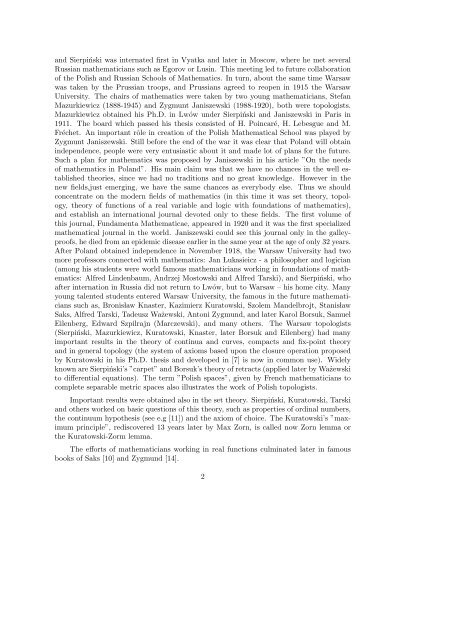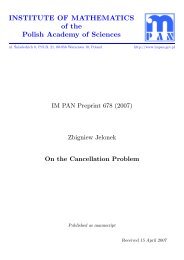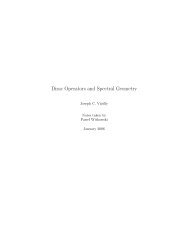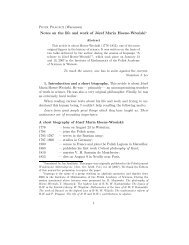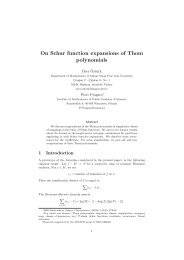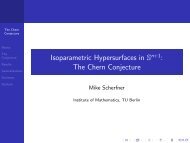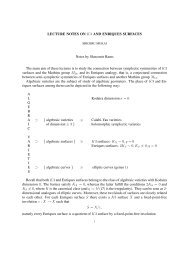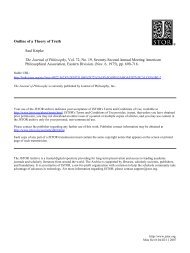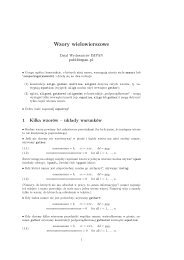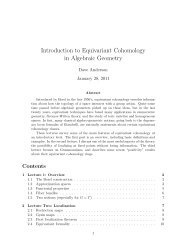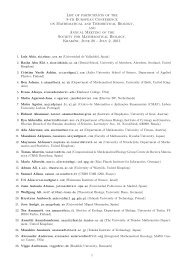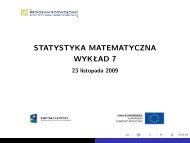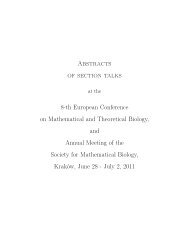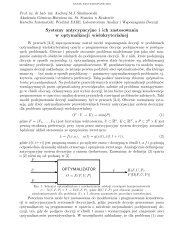A short history of Polish mathematics by W. ËZelazko (Warszawa) In ...
A short history of Polish mathematics by W. ËZelazko (Warszawa) In ...
A short history of Polish mathematics by W. ËZelazko (Warszawa) In ...
Create successful ePaper yourself
Turn your PDF publications into a flip-book with our unique Google optimized e-Paper software.
and Sierpiński was internated first in Vyatka and later in Moscow, where he met severalRussian mathematicians such as Egorov or Lusin. This meeting led to future collaboration<strong>of</strong> the <strong>Polish</strong> and Russian Schools <strong>of</strong> Mathematics. <strong>In</strong> turn, about the same time Warsawwas taken <strong>by</strong> the Prussian troops, and Prussians agreed to reopen in 1915 the WarsawUniversity. The chairs <strong>of</strong> <strong>mathematics</strong> were taken <strong>by</strong> two young mathematicians, StefanMazurkiewicz (1888-1945) and Zygmunt Janiszewski (1988-1920), both were topologists.Mazurkiewicz obtained his Ph.D. in Lwów under Sierpiński and Janiszewski in Paris in1911. The board which passed his thesis consisted <strong>of</strong> H. Poincaré, H. Lebesgue and M.Fréchet. An important rôle in creation <strong>of</strong> the <strong>Polish</strong> Mathematical School was played <strong>by</strong>Zygmunt Janiszewski. Still before the end <strong>of</strong> the war it was clear that Poland will obtainindependence, people were very entusiastic about it and made lot <strong>of</strong> plans for the future.Such a plan for <strong>mathematics</strong> was proposed <strong>by</strong> Janiszewski in his article ”On the needs<strong>of</strong> <strong>mathematics</strong> in Poland”. His main claim was that we have no chances in the well establishedtheories, since we had no traditions and no great knowledge. However in thenew fields,just emerging, we have the same chances as everybody else. Thus we shouldconcentrate on the modern fields <strong>of</strong> <strong>mathematics</strong> (in this time it was set theory, topology,theory <strong>of</strong> functions <strong>of</strong> a real variable and logic with foundations <strong>of</strong> <strong>mathematics</strong>),and establish an international journal devoted only to these fields. The first volume <strong>of</strong>this journal, Fundamenta Mathematicae, appeared in 1920 and it was the first specializedmathematical journal in the world. Janiszewski could see this journal only in the galleypro<strong>of</strong>s,he died from an epidemic disease earlier in the same year at the age <strong>of</strong> only 32 years.After Poland obtained independence in November 1918, the Warsaw University had twomore pr<strong>of</strong>essors connected with <strong>mathematics</strong>: Jan ̷Lukasieicz - a philosopher and logician(among his students were world famous mathematicians working in foundations <strong>of</strong> <strong>mathematics</strong>:Alfred Lindenbaum, Andrzej Mostowski and Alfred Tarski), and Sierpiński, whoafter internation in Russia did not return to Lwów, but to Warsaw – his home city. Manyyoung talented students entered Warsaw University, the famous in the future mathematicianssuch as, Bronis̷law Knaster, Kazimierz Kuratowski, Szolem Mandelbrojt, Stanis̷lawSaks, Alfred Tarski, Tadeusz Ważewski, Antoni Zygmund, and later Karol Borsuk, SamuelEilenberg, Edward Szpilrajn (Marczewski), and many others. The Warsaw topologists(Sierpiński, Mazurkiewicz, Kuratowski, Knaster, later Borsuk and Eilenberg) had manyimportant results in the theory <strong>of</strong> continua and curves, compacts and fix-point theoryand in general topology (the system <strong>of</strong> axioms based upon the closure operation proposed<strong>by</strong> Kuratowski in his Ph.D. thesis and developed in [7] is now in common use). Widelyknown are Sierpiński’s ”carpet” and Borsuk’s theory <strong>of</strong> retracts (applied later <strong>by</strong> Ważewskito differential equations). The term ”<strong>Polish</strong> spaces”, given <strong>by</strong> French mathematicians tocomplete separable metric spaces also illustrates the work <strong>of</strong> <strong>Polish</strong> topologists.Important results were obtained also in the set theory. Sierpiński, Kuratowski, Tarskiand others worked on basic questions <strong>of</strong> this theory, such as properties <strong>of</strong> ordinal numbers,the continuum hypothesis (see e.g [11]) and the axiom <strong>of</strong> choice. The Kuratowski’s ”maximumprinciple”, rediscovered 13 years later <strong>by</strong> Max Zorn, is called now Zorn lemma orthe Kuratowski-Zorm lemma.The efforts <strong>of</strong> mathematicians working in real functions culminated later in famousbooks <strong>of</strong> Saks [10] and Zygmund [14].2


